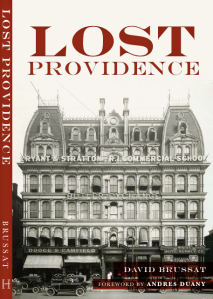
Computer Lab by Philip Johnson was Brown’s first modernist building. (midcenturymundane.wordpress.com)
Congratulations to Brown University for the Nobel won by one of its physics professors, Michael Kosterlitz. Moreover, congrats to Kosterlitz himself. His Nobel threw me for a loop. It was, I thought, for a discovery in topography, as if he’d discovered that Providence was built on seven hills so that it might be, topographically speaking, like Rome, which was also built on seven hills. But no, Kosterlitz discovered something in the field of topology, which has nothing to do with land forms or maps.
According to a story in today’s Journal, “Brown scientist shares Nobel Prize in physics,” Kosterlitz used “the physics of topology, a branch of mathematics that studies objects whose basic properties remain the same even if they are distorted or deformed, such as during bending or stretching.” Sort of like the process undergone by “truth” or “facts” during a U.S. presidential campaign, especially this year. But this year it has been discovered that they can be not just bent or stretched but broken, and it makes no difference at all. Maybe Kosterlitz deserves a Nobel in poli sci, too.
The seven hills of Providence: College Hill, Smith Hill, Federal Hill, Tockwotten Hill, Constitution Hill, Weybosset Hill, Christian Hill and Neutaconkanut Hill. The seven hills of Rome: Aventine Hill, Caetian Hill, Capitoline Hill, Esquiline Hill, Palatine Hill, Quirinal Hill and Viminal Hill.
The Computing Laboratory, which I have included just to bring an iota of architecture to this post, opened in 1961 at Brown, was designed by Philip Johnson, already a celebrity architect (and a Nazi). It was intended to house an IBM7070, whose computing power, if I may be allowed a guess, would fit into your iPhone. The Computing Lab, on George Street, is now part of Brown’s Applied Math Department. It is actually one of the few modernist buildings I can abide, and much nicer than Johnson’s later and more well-known building at Brown, the List Art Center on College Street, a Brutalist erection completed in 1971.


